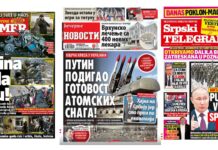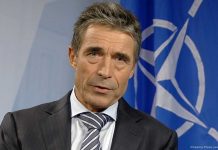Every day millions of videos, images, news and personal comments are uploaded on websites, chat rooms and other social web applications, making it hard for the average citizen to find his way through the overflow of information.
At the same time, the new real-time technologies allow us to be more than just information consumers. Thanks to digital cameras and mobile phones, photos and videos are spread within seconds across the globe, thus turning millions of people into information do-ers.
But the current communication environment also has a number of downsides. For national governments and international organisations it is much harder to get their messages across. The top-down communication patterns of the Cold War era are increasingly being replaced by people-to-people diplomacy and peer-to-peer relationships and networks. Not surprisingly, institutional communication channels rank among the least trusted.
This emphasises the ever-greater need for well-planned public diplomacy efforts. Strategic communications, place branding and public affairs are widely seen as essential tools to win over hearts and minds of foreign audiences and convince them that a country’s or organization’s values, goals and desires are worth supporting. With a lot of governments hiring PR firms to improve their image abroad, the branding industry is said to have skyrocketed over the past ten years.
While it is already difficult for countries to change their image to the better, it is definitely a hard challenge for multilateral bodies. Most citizens find the policy-makings of large international organisations like the EU or UN too complex and far away from their day-to-day concerns.
Where does the Transatlantic Alliance fit in this, in particular now that NATO approaches another Summit that will take place in Lisbon at the end of the year?
The good news is that the Alliance still enjoys a recognisable brand. As international and national surveys show, NATO is widely associated with security and defence and perceived as a transatlantic provider of peace and security. According to the Transatlantic Trends that the German Marshall Fund published on 15 September 2010, majorities (59%) in 11 European countries and the United States (60%) still believe that NATO is essential for their security. The exception is Turkey where only 30% believe NATO is essential.
Interestingly, 62% of the 11 European nations would also support a NATO role outside Europe, whereas 32% prefer NATO to focus on Europe itself. In the US support is much larger with 77% saying that NATO should act outside Europe, if need be. Even in Russia opinions about NATO are improving. In 2009, only 24% of Russians held a positive view of NATO; currently 40% express a favorable opinion, whereas 40% still view NATO unfavorably.
But the Allies are well advised not to take public support for NATO for granted. First, the NATO-led operation (ISAF) in Afghanistan remains a case in point. The prevailing view in many European nations is to see the number of their troops reduced or their forces totally withdrawn. As the GMF survey revealed, more than half of West Europeans want to see their troops being withdrawn from or reduced in Afghanistan with Poland being highest on the scale (77%) and Turkey lowest (with 47%). Support for NATO’s operation in Afghanistan has also started to decrease in the United States where 41% wish their troops coming home or being substantially reduced.
Against this background the NATO Allies must do a better and more coherent job to explain their strategy in Afghanistan and convince parliamentarians and the public why it is important to finish the job in Afghanistan.
But at the same time the Alliance needs to tackle another fundamental challenge. Simply said, it must better explain what the Transatlantic Alliance is all about in the 21st century. National and international surveys demonstrate clearly that the public at large, and particularly the post-Cold-War generation, has only foggy ideas of the NATO’s new missions and policies. While there still exists a considerable degree of trust and confidence in the organization as such, many people have difficulties relating NATO to the new global security threats. Others, again, question the need to invest in defence after the end of the Cold War or view NATO primarily as a protector against Russia.
But all of these perceptions and assumptions are wrong. The sad fact is that our world has even become more fragile after the end of the Cold War. Terrorism, the proliferation of weapons of mass destruction, threats posed to our energy security, information infrastructure and commercial shipping as well as regional conflicts are only some of the most pressing security challenges that require urgent responses. More than ever, governments, organisations and other players in the international arena need to work together to address them, in order to find support for solutions and change. No single government can tackle this expanding number of problems on its own. The Alliance remains the best and most effective transatlantic forum to do exactly this. But NATO’s current and future efforts to play an efficient role as a security provider have not been fully understood by our publics.
So how does NATO respond to this? Surely, the Allies have come quite a long way in embracing a new and modern understanding of their common communication policies. Now transparency, responsiveness, accurancy of information and direct engagement with people across Allied territory and far beyond have become the pillars of NATO’s public diplomacy philosophy.
More than ever, journalists, think tankers, decisions-makers and NGOs are populating the Headquarter’s corridors or meet with NATO civilian and military experts in countless public gatherings. But NATO leaders have also become more accessible for average citizens. Every year thousands of visitors come to the Headquarters to discuss the transatlantic security agenda with national and NATO officials and, if he is around, even with the NATO Secretary General.
For sure, NATO does not hide behind confidential documents, nor does it avoid critical questions. In the past years it has especially einforced its efforts to reach out to the young generation, through facilitating networks among students and young political leaders, offering summer schools and fellowships and organising seminars and workshops across NATO and partner nations
It goes without saying that the organization has also overhauled its technological capabilities, aimed at bringing the NATO website and other audiovisual tools and products up to a par. Online lectures, videos and discussions have made NATO’s interface to the outside world more transparent and interactive. There are no tabus: topics range from the new Strategic Concept all the way to the challenging operation in Afghanistan.
When it comes to the use of new media tools, NATO’s Secretary General, Anders Fogh Rasmussen, can surely be called a frontrunner. He runs his personal Facebook and Twitter profiles and responds directly to questions and comments from ordinary citizens in his digital “Secretary General’s Corner’.
For sure, NATO has come to understand how important a modern and responsive public diplomacy strategy is for the organisation. They have grasped that NATO’s image, for good or for worse, rests in their own hands. Ultimately, however, a strong and positive brand can never be constructed through slogans and logos alone. It needs to be earned through convincing policies and political actions – and this is exactly what the 28 Allies are trying to achieve together on a daily basis.
The forthcoming Summit in Lisbon will be an excellent opportunity for the Allies to demonstrate their resolve to continue building an efficient transatlantic security partnership. They will not hide in secured conference rooms but be prepared to carry their messages loudly and clearly to the people because it is them who matter most.
|
16/09/2010 |
|
Author : Stefanie Babst |








